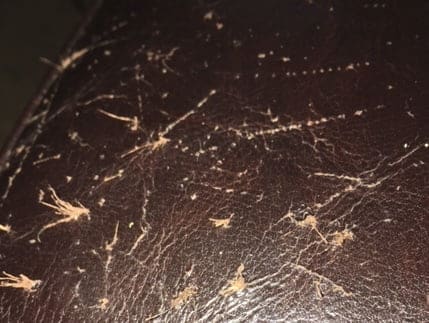Repairing cat scratches on vinyl or faux leather is painstaking work, and perfection is nearly impossible (unlike similar damage to real leather).


The results are almost as good (not to mention faster and cheaper) by tacking down or trimming away any flaps and then staining the exposed fabric with a similar color. However, the gouges will remain, and these areas will not repel water nor reflect light without a leather filler.
How to Repair Cat Scratches on Vinyl or Faux Leather with Leather Filler Putty
- Trim away any fibers or threads (or stuff them back into the puncture).
- Subpatch any holes that are larger than the size of a pencil eraser.
- Use a large needle and a flexible fabric glue (or even filler putty) to tack down every little flap, and scrape away any excess. If any flap has stretched and no longer fits into its respective puncture, cut it away completely.
- Use a small paintbrush to apply color to the polyester or mesh in each puncture.
- Use alcohol to remove any glue or color from surrounding undamaged areas.
- Let the glue and color completely dry.
- Use a large needle tool to apply a tiny dab of filler putty to each gouge.
- Level it smooth with a plastic spreader or glossy business card.
- Allow to cure under sunshine or an incandescent bulb.
- If necessary, use rubbing alcohol to melt the filler and smooth any uneven areas.
- Repeat until an even surface is achieved. The filler may shrink as it cures, so additional applications may be necessary (typically 2-3), and even then it may still appear pitted, bumpy, or uneven. One can, instead, do a large pass of filler over an area of damage. Beware of a heavier-handed approach on bonded or polyurethane faux leather, though, because these materials delaminate and may damage your repair.
- Apply a final thin layer of filler putty and emboss the wet filler with saran wrap or a gloved hand to impart texture. Allow to cure.
- If necessary, apply more color and clear finish.
PLEASE DO NOT DECLAW YOUR CAT!
This procedure is amputation of the bone to the last knuckle, not mere removal of the nail. It’s banned in many countries and opposed by the Humane Society and the American Society for the Prevention of Cruelty to Animals. Declawing can decrease use of a litter box and increase biting. Cats are smart creatures and can be easily trained with a spray bottle of water (set on shoot-to-soak) and pheromone sprays. Give them a scratching post where they can engage in their natural behavior. You can also trim their claws with pet nail clippers. Others report success using Soft Paws or other claw caps.
Hello my name is Sheena and I have a slight scratch very minor but I would like to fix it on my couch. It is from my dog laying on the floor and stretching and when doing so his nails swiped the bottom of the couch. I’m not sure If I can send pictures but most of your examples are very extreme and mine is not so I’m at a loss.
If you can feel the damage, it would benefit from repair, otherwise color will correct it. You can fill out our evaluation or email photos to info@rubnrestore.com.
I have a hot pink jojo Siwa bed and my cat has scratched the crap out of it. My husband wants to declaw her and I am dead set against this. So I desperately need to fix my daughters bed. Please help.
The fault is in the faux leather which is trash material! Real leather would be easily repaired. Tell your husband declawing is amputation and cruelty. There are ways to train the cat. When your daughter gets older, get a real leather (used) headboard and hand paint whatever she wants on it. You can update it as the years go by, and it’ll last forever, through many ill-mannered cats.
Thank u so much for that advice. I appreciate it.
I have little claw holes/snags from a kitten. Will this work?
As the article states, “Repairing cat scratches on vinyl or faux leather is very painstaking work. As professional repair artisans, we learned to walk away from this kind of damage, because perfection is impossible.” Sometimes it’s no less noticeable. Just different. Sometimes it’s an improvement. Less is more. If it were real leather, you could get flawless results with tiny drops of super glue catalyzed with sanding, but this method cannot be used on synthetics.
I used this product 2 years ago on a leather couch and love seat I was given. It was horrible and I was sure I was wasting my time and money. It took a long time but the results with patience and time were worth it. I can only say it looks amazing. There were tons of claw marks and small tears all over both pieces. Patience. I used super glue on a tooth pick to fill all cat holes after lightly sanding them. Same with the tears. More light sanding. More filling with super glue. Stained with a matching color and put the shine to it. It was beautiful. Still is. Love this stuff!
Where can I find color to repair? My cat uses the end of our couch as his personal scratching pad (I just saw it AND he WILL be stopped.)
After reading this I’m convinced color is the only way to go since this is fabric faux leather and it’s only 2 years old.
There couches are dark coffee brown.
Thank you for all of your advice and help.
Sharon
Mahogany or Espresso are your best bet and can be found in our colors catalog here.